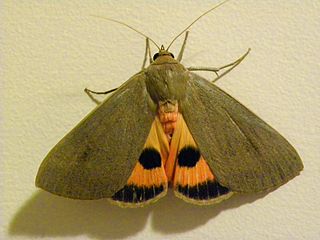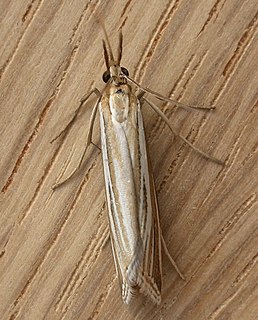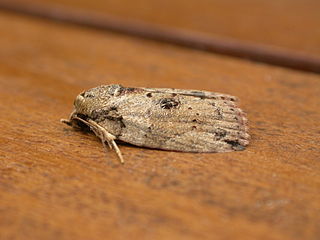
The Pyralinae are the typical subfamily of snout moths and occur essentially worldwide, in some cases aided by involuntary introduction by humans. They are rather rare in the Americas however, and their diversity in the Australian region is also limited. Altogether, this subfamily includes about 900 described species, but new ones continue to be discovered. Like many of their relatives in the superfamily Pyraloidea, the caterpillar larvae of many Pyralinae – and in some cases even the adults – have evolved the ability to use unusual foods for nutrition; a few of these can become harmful to humans as pests of stored goods.

The Pyralini are a tribe of snout moths described by Pierre André Latreille in 1809. They belong to the subfamily Pyralinae, which contains the "typical" snout moths of the Old World and some other regions. The genus list presented here is provisional.

The brown-dotted clothes moth is a species of tineoid moth. It belongs to the fungus moth family (Tineidae), and therein to the nominate subfamily Tineinae. It is the type species of its genus Niditinea.

Thallarcha sparsana, the fair footman, is a moth of the subfamily Arctiinae. The species was first described by Francis Walker in 1863. It is found in the Australian states of Victoria, New South Wales and Queensland.

Hednota relatalis is a moth of the family Crambidae described by Francis Walker in 1863. It is found in Australia, in Australian Capital Territory, Victoria, Tasmania, South Australia, and Western Australia.
Ubida is a genus of moths of the family Crambidae.

Scirpophaga is a genus of moths of the family Crambidae described by Georg Friedrich Treitschke in 1832. Asian species include significant rice stemborer pests.

Sandava is a genus of moths of the family Erebidae. The genus was erected by Francis Walker in 1863.

Targalla is a genus of moths of the family Euteliidae. The genus was erected by Francis Walker in 1858.

Zermizinga is a moth genus in the family Geometridae erected by Francis Walker in 1863. Species within this genus include Zermizinga sinuata, the lucerne looper or spider moth, which was described by Warren in 1897, as well as Zermizinga indocilisaria, which was described by Walker in 1863.

Berta chrysolineata is a species of moth of the family Geometridae described by Francis Walker in 1863. It is widespread from the Indo-Australian tropics of India, Sri Lanka to the Solomons.

Nanaguna breviuscula, the pigeonpea pod borer, is a moth species of the family Nolidae. It is found from Sri Lanka and India east to Samoa. In Australia it is found in the Kimberleys in Western Australia, the northern part of the Northern Territory and from the Torres Strait Islands and Queensland to Sydney in New South Wales.

The Chrysauginae are a subfamily of snout moths. They are primarily Neotropical and include about 400 described species.

Targalla subocellata is a moth in the family Euteliidae first described by Francis Walker in 1863. It is found in Taiwan, the north-eastern part of the Himalayas, Sundaland, the Philippines, Sulawesi, the southern Moluccas, New Guinea and Queensland.
Calamotropha delatalis, is a moth in the family Crambidae. It was described by Francis Walker in 1863. It is found in Sri Lanka and Australia, where it has been recorded from Queensland, New South Wales and Victoria.
Ubida amochla is a moth in the family Crambidae. It was described by Turner in 1922. It is found in Australia, where it has been recorded from Queensland.
Ubida hetaerica is a moth in the family Crambidae. It was described by Turner in 1911. It is found in Australia, where it has been recorded from the Northern Territory.
Ubida holomochla is a moth in the family Crambidae. It was described by Turner in 1904. It is found in Australia, where it has been recorded from Queensland and the Northern Territory.











